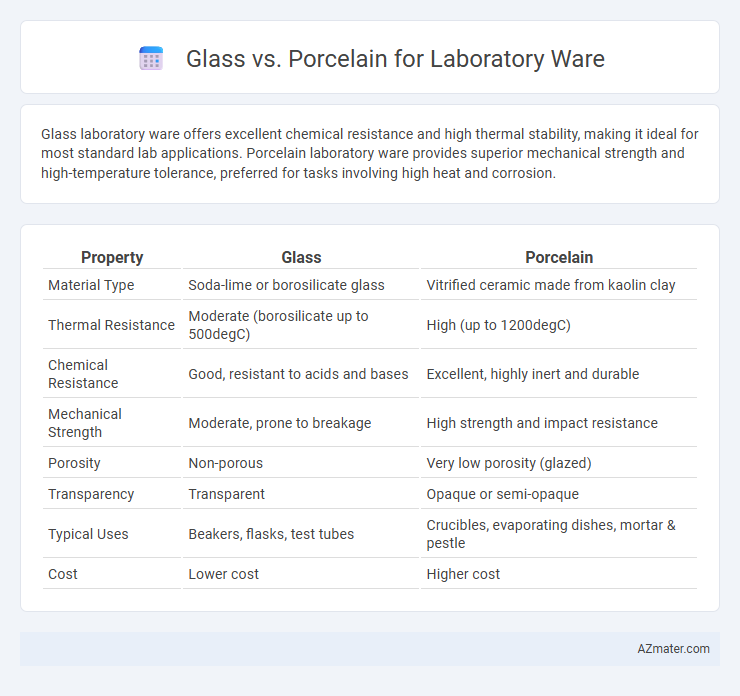Glass laboratory ware offers excellent chemical resistance and high thermal stability, making it ideal for most standard lab applications. Porcelain laboratory ware provides superior mechanical strength and high-temperature tolerance, preferred for tasks involving high heat and corrosion.
Table of Comparison
| Property | Glass | Porcelain |
|---|---|---|
| Material Type | Soda-lime or borosilicate glass | Vitrified ceramic made from kaolin clay |
| Thermal Resistance | Moderate (borosilicate up to 500degC) | High (up to 1200degC) |
| Chemical Resistance | Good, resistant to acids and bases | Excellent, highly inert and durable |
| Mechanical Strength | Moderate, prone to breakage | High strength and impact resistance |
| Porosity | Non-porous | Very low porosity (glazed) |
| Transparency | Transparent | Opaque or semi-opaque |
| Typical Uses | Beakers, flasks, test tubes | Crucibles, evaporating dishes, mortar & pestle |
| Cost | Lower cost | Higher cost |
Introduction to Laboratory Ware Materials
Laboratory ware materials primarily include glass and porcelain, each offering unique chemical resistance and thermal stability essential for various scientific applications. Borosilicate glass provides excellent transparency and withstands high temperatures, making it ideal for precise measurements and reactions. Porcelain, known for its durability and resistance to chemical corrosion, is commonly used in crucibles and evaporating dishes where high-temperature operations are frequent.
Overview of Glassware in Laboratories
Glassware in laboratories is primarily made from borosilicate glass, renowned for its exceptional thermal resistance, chemical inertness, and mechanical durability, making it ideal for heating and mixing chemicals safely. It offers superior clarity for visual observations and can withstand repeated sterilization processes without degrading. Borosilicate glassware's non-porous surface prevents contamination, ensuring precise experimental results and reliable long-term use in scientific applications.
Overview of Porcelain Ware in Laboratories
Porcelain laboratory ware is prized for its chemical inertness, thermal stability, and resistance to acids and alkalis, making it ideal for tasks involving strong reagents and high-temperature processes. Its non-porous surface ensures minimal contamination and easy cleaning, which is essential for precise analytical results. Compared to glass, porcelain offers enhanced durability under abrasive handling and sustained heat exposure, though it lacks the transparency needed for visual observation.
Chemical Resistance: Glass vs Porcelain
Glass laboratory ware exhibits superior chemical resistance to most acids, alkalis, and solvents, maintaining integrity without leaching or degradation. Porcelain may resist high temperatures and some corrosive agents but is more susceptible to alkalis and hydrofluoric acid, which can etch or damage its surface. Selecting glass ensures enhanced durability and reliability in chemical applications requiring exposure to diverse reagents.
Thermal Stability and Heat Tolerance
Porcelain laboratory ware offers superior thermal stability and heat tolerance compared to glass, withstanding temperatures up to 1400degC without deformation. Glass, particularly borosilicate types, tolerates rapid temperature changes and sustained heat up to approximately 500degC but risks cracking under extreme thermal stress. Porcelain's ceramic structure provides chemical inertness and resistance to thermal shock, making it ideal for high-temperature applications requiring durability and precise thermal performance.
Mechanical Strength and Durability
Glass laboratory ware, particularly borosilicate glass, offers excellent chemical resistance but exhibits lower mechanical strength and higher brittleness compared to porcelain. Porcelain laboratory ware demonstrates superior mechanical strength, impact resistance, and durability under thermal stress, making it ideal for applications involving heavy handling or repeated heating cycles. The inherent toughness of porcelain reduces the likelihood of chipping or cracking, ensuring longer service life in demanding laboratory environments.
Suitability for Specific Laboratory Applications
Glass laboratory ware, such as borosilicate glass, offers excellent chemical resistance and thermal stability, making it ideal for high-temperature experiments, acid handling, and visual observations of reactions. Porcelain, renowned for its porosity and durability at elevated temperatures, is suited for crucibles and evaporating dishes in processes like calcination and drying where structural integrity and heat resistance are critical. Selecting between glass and porcelain depends on the application's thermal requirements, chemical exposure, and the need for material transparency or porosity in laboratory procedures.
Cleaning, Maintenance, and Reusability
Glass laboratory ware offers excellent chemical resistance and can withstand high-temperature sterilization methods such as autoclaving, making it easy to clean and highly reusable. Porcelain is more durable against mechanical abrasion and thermal shock but requires more careful handling to avoid chipping, with cleaning often needing specialized detergents to maintain its surface integrity. Both materials support multiple uses, but glass typically has longer service life due to its resistance to chemical degradation and ease of maintenance.
Cost Comparison: Glass vs Porcelain Lab Ware
Glass laboratory ware generally offers a lower upfront cost compared to porcelain, making it more budget-friendly for routine use in labs. Porcelain lab ware, though more expensive initially, provides superior durability and resistance to thermal shock, reducing replacement frequency and long-term expenses. When factoring in maintenance and longevity, porcelain can present better overall value despite its higher initial price.
Environmental Impact and Sustainability
Glass laboratory ware offers superior sustainability due to its recyclability and long lifespan, reducing environmental waste compared to porcelain. Porcelain requires high-temperature firing during production, leading to higher energy consumption and carbon emissions. Recycling glass laboratory equipment minimizes landfill impact, making it a more environmentally friendly choice in scientific settings.

Infographic: Glass vs Porcelain for Laboratory Ware
 azmater.com
azmater.com